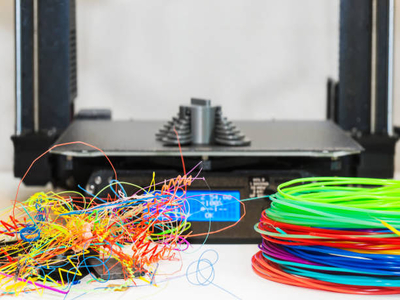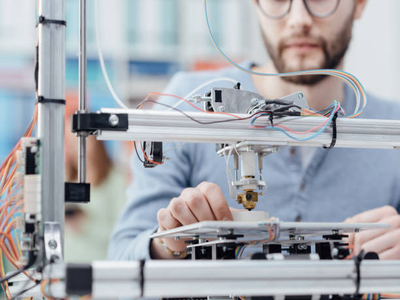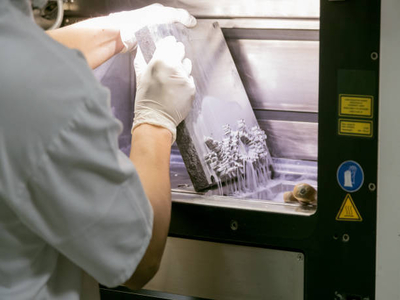A common issue for PLA filament is that it can become brittle. If you have ever had brittle PLA filament, then you’re not alone.
This blog post will discuss some of the most common causes and how to fix brittle PLA filament.
We’ll also provide some tips for preventing this problem from happening!
Why PLA Filaments Get Brittle

There are a few reasons why your PLA filament might get brittle.
Moisture
Moisture is one of the most common causes of brittle PLA filament.
If your filament is not stored properly, it can absorb moisture from the air and cause the filament to become brittle and break easily.
To fix this problem, you need to keep your filament in an airtight container.
Temperature
Temperature changes, especially exposure to extreme temperatures, can also cause PLA filament to become brittle.
To fix this problem, you need to ensure that your filament is stored in a cool, dry place, preferably in an airtight container.
Exposure to Sunlight
Exposure to sunlight can cause your PLA filament to become brittle and break down.
To fix this problem, you need to ensure that your filament is stored in a dark place.
The video below further illustrates why PLA filaments get brittle and keep breaking. Check it out!
How to Fix Brittle PLA Filament
Now that we know some of the most common causes of brittle PLA filament, let’s discuss how to fix brittle PLA filament.
Method 1: Heating PLA Filament Roll
One of the easiest ways to fix this situation is to dry the filament or heat the filament roll to make it soft and more pliable.
To do this, you will need a heat gun or an oven.
If you are using a heat gun, set the heat gun to low and hold it about 6 inches away from the filament roll.
Slowly move the heat gun back and forth over the entire surface of the roll until it softens.
You can also place the filament roll in an oven that has been preheated to 200 degrees Fahrenheit (104 degrees Celsius).
Place the filament roll on a baking sheet and bake it for about 30 minutes, allow to cool before touching.
Method 2: Adding a Stabilizer

Another way to fix brittle PLA filament is to add a stabilizer.
A stabilizer is a substance that will help to strengthen the filament and make it less likely to break.
One of the most common stabilizers is glycerin.
You can add glycerin in 3-to-1 water to glycerin ratio to your PLA filament and let it soak in this solution for 24 hours, then remove it and allow it to air dry.
Read More: Best PLA Brand. We put PLA filaments to the test and here are our favorites (and why!)
Method 3: Changing the Printing Temperature
Another way to fix brittle PLA filament is to change the printing temperature.
If your PLA filament is too cold, it can become brittle and break easily. To fix this problem, you need to increase the printing temperature.
The exact temperature will vary depending on the type of PLA filament that you are using.
However, most kinds of PLA filament should be printed at temperatures between 392 to 428 degrees Fahrenheit.
Method 4: Changing the Bed Temperature
If you have trouble with fixing your brittle PLA filament, you may also need to change the bed temperature or the temperature of the build plate that your PLA filament is sitting on.
If the bed temperature is too low, it can cause your PLA filament to become brittle and break easily.
To fix this problem, you need to increase the bed temperature. The exact temperature will vary depending on the type of PLA filament that you are using.
However, most kinds of PLA filament should be printed on a bed that has been heated to between 122 and 140 degrees Fahrenheit.
Method 5: Changing the Printing Speed

The printing speed can also affect the brittleness of your PLA filament.
If your PLA filament is printed too slowly, it can become brittle and break easily.
To fix this problem, you need to increase the printing speed. The exact speed will vary depending on the type of PLA filament that you are using.
However, you should print most kinds of PLA filament at speeds between 30 and 60 millimeters per second.
Preventing Brittle PLA Filament
PLA filament is notorious for being brittle and snapping due to moisture in the air interacting with the PLA.
PLA is anhydrous, meaning it doesn’t contain water, but can absorb it from the air and when this happens, it becomes frail and breakable.
To combat this issue, there are preventative measures that you can take.
- Keep Your PLA in an Airtight Container: This will help keep moisture out and protect your filament from absorbing any excess moisture from the air.
- Use a Desiccant Pack: Desiccant packs are little packets containing drying agents that help absorb moisture from the air.
- These can usually be found at your local hardware store or online. Just place them in your filament storage container to help keep the air dry, and your PLA protected.
- Store Your PLA In A Cool, Dry Place: Again, this will help keep moisture out and prevent your filament from absorbing any excess moisture from the air.
- Buying Better Quality PLA Filament: If you are having chronic trouble with brittle PLA filament, you may want to consider purchasing better quality PLA filament.
There are many different brands and types of PLA filament on the market, and some are better than others.
When choosing a PLA filament, look for one made from virgin materials and designed for use in desktop FDM 3d printer types.
These filaments are generally more expensive than lower-quality filaments, but they are less likely to break and easier to print with.
By taking these preventative measures, you can help to ensure that your PLA filament stays strong and doesn’t become brittle and break easily.
Conclusion
Brittle PLA filament can be a frustrating problem to deal with, but thankfully, there are solutions to prevent this aggravating problem.
If your PLA filament is too brittle, try changing the printing temperature or speed. You can also try changing the bed temperature or storing your PLA in a cool, dry place.
If you are still having trouble with brittle PLA filament, you may even consider buying a better quality PLA filament.
READ MORE